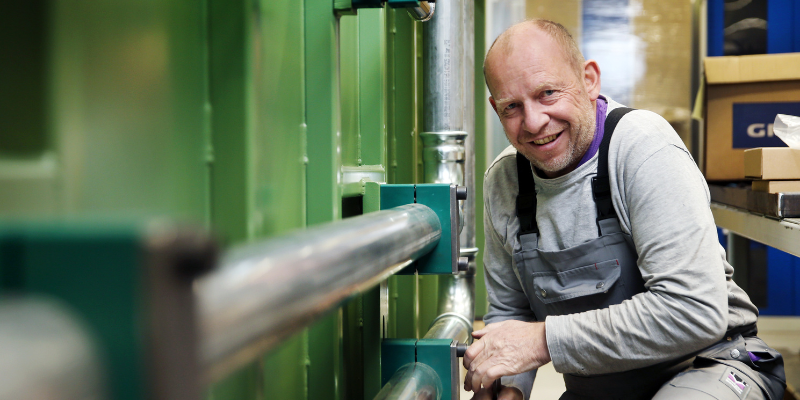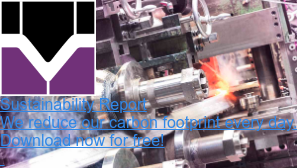How do Companies determine their Carbon Footprint?
The ambitious political announcement that the EU aims to become climate neutral by 2050 sets each individual member state new industrial and economic challenges that come with adopting the mandatory EU Green Deal. European companies must now quickly find ways and means of successively reducing their CO2 emissions over the next few years.
And as if this Herculean task wasn’t enough, one of the most important requirements hasn't yet been defined: What exactly is a Carbon Footprint, and how is it calculated? Which challenges does a company have to master and which steps have to be taken in order to successfully set the course for future sustainability? In this article, we’ll share some food for thought, backed up with some empirical values to help you get a handle on a potentially perplexing subject.
What is a Carbon Footprint?
The Carbon (or C02) footprint, describes the result of an emissions calculation, or a CO2 balance. Carbon footprints can be calculated for an entire company, for departments, for specific products, or for individual projects or investments. The carbon footprint reflects the amount of greenhouse gasses released by a specific activity or process. When determining the carbon footprint of a company, it’s fundamentally important when and where the emissions occur. For example:
- in the area of a company’s own production
- through purchasing the required energy, products and services
- as part of the upstream and downstream value chain (transport, logistics), when delivering raw materials, auxiliary materials and supplies, and when transporting them to the customer
- through business trips, hotel accommodation, events etc., or
- on the consumer end in the use or recycling and disposal of the manufactured goods
Why do Companies need to measure their Carbon Footprint?
For companies, the carbon footprint is the most important tool for assessing their greenhouse gas emissions. It figures into product life cycle assessment, it’s integral for sustainability reports, and it’s taken into account in cost planning. The CO2 footprint shows which areas are responsible for the most emissions, where there are hot spots in the production chain, and where there’s potential for improvements and savings. In addition, it forms the basis for the formulation of a company’s science-based climate targets.
Information on the CO2 footprint is also becoming increasingly important for a company’s stakeholders:
- Investors see enormous growth and earnings potential in the promotion of sustainable companies.
- Banks take into account the ESG criteria (environmental social governance) in accordance with the European banking supervisory authority and applicable EBA (European Banking Authority) guidelines. The interest on a loan is based, among other things, on whether the ESG criteria are met (this can even determine whether a loan is approved at all).
- Customers are increasingly asking for green products and services, taking this aspect into account in their purchasing decisions.
- Buyers check the climate protection standards of producers and suppliers to optimize their own CO2 footprint.
- Young talent see ecological efforts and green initiatives of a company more and more as important criteria when choosing their future employer.
How is a Carbon Footprint calculated?
The most important international standards for calculating the CO2 footprint are the Greenhouse Gas Protocol and the ISO Standard 14064. These assign greenhouse gas emissions from companies, as well as for the public sector, to the following three areas:
- Scope 1: Directly generated emissions from fuels during operation or through transport activities, as well as fugitive emissions (e.g. unintentional leaks).
- Scope 2: Emissions from purchased energy, such as: electricity, steam, heating or cooling.
- Scope 3: All other indirect emissions that a company releases as part of its value chain.
4 Steps towards a better CO2 Balance
The following 4 steps are recommended for determining a meaningful greenhouse gas balance:
Step 1: Define your Goals and Limits
Define your company’s parameters, and decide which scopes the footprint will be created for.
Step 2: Collect Activity Data
Determine which of your activities and processes cause CO2 emissions and which scopes they belong to.
Step 3: Determine C02 Emission Factors
Define the emission factors associated with a given activity or process, and determine how CO2-intensive they are.
Step 4: Create your Greenhouse Gas Balance
Based on the previous steps, you can consolidate your company's emissions into a meaningful greenhouse gas balance sheet.
Pro Tip:
Be systematic. Start with Scope 1 and determine where direct emissions occur in your company. Then, as part of Scope 2, look at the sources from which you get your energy (electricity, heating, etc.) and, last but not least, you can deal with Scope 3.
Challenges in calculating your Carbon Footprint
Every company is different. When it comes to calculating your CO2 footprint however, there are some hurdles we all have to overcome. Sooner or later, every organization has to face the following challenges as it embarks on the path to more climate transparency and sustainability:
- Different Interpretations of Standards
Are emissions attributed to the product or to the company? And where do you draw the line? This problem comes up in connection with greenhouse gas emissions that do not arise directly from the manufacture of a product, with tangentially related actions like business trips.
There are many approaches when it comes to calculating a carbon footprint, and even the implementation of standards such as the GHG Protocol is to a certain extent a matter of interpretation. Some companies only deal with Scope 1 and 2 emissions, others also consider Scope 3, but sometimes only in a few categories. Comparable, compatible results across companies is still often only wishful thinking. - Poor Database & Quality
When using standards, the calculation method as well as the underlying factors can lead to problems. Although there are already many tools for companies to calculate their CO2 footprint more easily (e.g. from CarbonCare), the question of the source and quality of the data used for this always arises.
Don't be put off by this - companies can usually access a large amount of primary data. If not, you should simply start with estimates and rough calculations. In this way you can create an initial database which you can build upon and work towards more solid results. Starting with estimated values and prioritizing according to expenses - e.g. in regards to purchased goods - offers the advantage that you can learn to assess the relevance of certain factors and can prioritize. If an emission factor is small compared to others, then rough assumptions will also suffice in the future.
Pro Tip:
When doing your balancing, pay attention to the comprehensiveness, accuracy, transparency, consistency and relevance of your data.
- Finding the right Emission Factors
With a multitude of different information and values to look at it can be extremely difficult, especially for non-specialists, to pinpoint the right emission factor for, as an example, a waste product or a specific raw material. Regardless of the material quality, it’s tricky to understand everything that has to be included in the calculation in the upstream value chain of steel or fuels, for instance.
You can try to collect real data from the suppliers (primary data). If these aren’t available, they should be compared with values from existing databases for secondary data, such as ecoinvent or GaBi and extrapolating from this, local emission factors can be calculated. If the databases don’t provide usable data, publications by institutes, ministries, or scientific publications are the next alternative. If satisfactory results are not obtained in this way either, working with estimated values is recommended here as a starting point. - Lack of Comparability
Although some CO2 standards are available, it’s not very practical to compare the emission value of steel with that of a coffee machine to find useful benchmarks. So is it ever useful to make comparisons? Looking at the currently available knowledge, only a comparison within the same industry provides useful results, with each database being based on different calculation factors which agree relatively rarely.
How we determine our Carbon Footprint at Welser Profile
We’ve seen that determining your CO2 footprint isn’t always easy for various reasons, and sometimes poses a significant challenge for companies. So how do we at Welser Profile deal with the fact that we know our biggest emission factor - purchased steel - very well, while recognizing that this same purchased steel is bread & butter ? The sustainable use of steel is not a dream of the future for us, but a core component of our everyday working life, and we have to constantly improve how we work towards achieving our goal of higher sustainability.
At Welser Profile we use these 4 measures to determine our CO2 footprint:
- Introducing an Environmental and Energy Management System
We’ve implemented an environmental and energy management system that brings together all the information relevant to determining operational CO2 emissions. This includes, among other things: data on packaging, tool steel, waste, as well as raw materials, auxiliary materials and supplies. - Gathering Knowledge
Based on the 2019 financial year, we have built up an internal knowledge database over several months with a great deal of effort and according to the principle of “learning-by-doing”. Off the back of this, we were able to make more well-founded calculations and accurately determine our CO2 footprint. As a result, we’ll now look at the areas where we can define targets for reducing emissions and plan corresponding measures. In order to better determine the company-related CO2 emissions, an annual report is also planned to summarize all relevant information in a centralized and comprehensible manner. - Integrating Outside Know-How
Regular external scrutiny is very important, especially when you are heading into unknown territory when using the learning-by-doing principle. At Welser Profile, we have our plans and measures checked by experienced outside experts. We’re currently running a cooperation project with Ecoplus, whose consultants are helping us with the Scope 3 calculation and with choosing the right emission factors. We work together with their experts to answer those questions that specifically relate to the requirements of our industry or our company. - Using the Modular Principle for Product-Related Carbon Footprint
A process is currently being developed to determine the product-related CO2 footprint, which should be validated over the course of 2023. Its basis is the introduction of a modular principle. Based on the previous year's values, the calculation should be carried out taking into account the following variables:
- Delivery of the raw material
- Profile production with the associated energy consumption
- Resources used
- Transport of our profiles to the customer
Final Thoughts: Take Initiative to meaningfully determine your Carbon Footprint
The topic of climate change and sustainability is increasingly jumping to the top of the list of operational challenges, and it’s not going to get any less important in the near future, not least because of pressure from legislators. It’s all the more important that companies now take action themselves, deal with the topic in detail and set the necessary course for implementation. Learning by doing is an important part of the process. Although external consultants can provide important input, internal knowledge building is essential for the development of new standards and the implementation of related measures.
Pro Tip:
Make sure your organization has the necessary human resources in place. Databases alone are not sufficient for calculating your carbon footprint. Specialists are needed to find the right data, merge and evaluate it accordingly.
Get started, try different approaches and feel your way along. The only thing you can really do wrong is stick your head in the sand and do nothing. Everything else is a step in the right direction.
Read more
Similar articles

Green Steel in Roll Forming – The same thing, only greener?

Sustainable Product Development: 7 Tips for reducing Waste and CO₂


